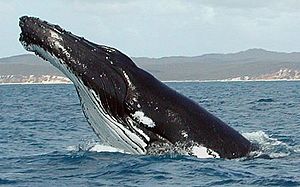Whale watching in Australia facts for kids
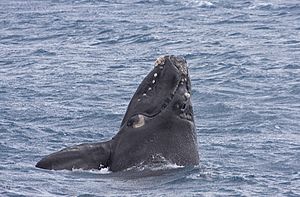
Whale watching in Australia is a very popular activity for both locals and tourists. People love to see these amazing creatures in their natural home. In 2008, watching whales and dolphins brought in about 31 million Australian dollars to the country's economy. Around 1.6 million tourists took part in this activity.
Long ago, from 1788 to 1978, people used to hunt whales in Australia for business. But now, whales are protected. The Australian Whale Sanctuary was created in 1999 to keep dolphins and whales safe from hunting.
The most common whales you'll see in Australia are Humpback whales. You might also spot southern right whales, minke whales, and blue whales. To keep the whales safe, boats must stay at least 300 meters (about 984 feet) away from them.
Contents
Where to See Whales
You can find great spots to watch whales all around Australia's long coastline. Each coast offers different experiences and types of whales.
West Coast Whale Watching
In Western Australia, you can watch whales near Cape Naturaliste and Cape Leeuwin. These capes are where the Indian and Southern Oceans meet. Whale watching trips also leave from cities like Perth and Fremantle. You can even go as far north as Broome to see them.
Southern Australia Whale Watching
The Southern Ocean has many places to see whales, either from the land or from a boat. Southern right whales are often seen from June to August along the south coast. You can easily spot them from the coast around Encounter Bay near Victor Harbor. Sometimes, up to a hundred whales can be seen from the cliffs at the top of the Great Australian Bight near Yalata.
Albany, a town on the south coast of Western Australia, used to be the last place in the Southern Hemisphere with a whaling station. Now, it's a busy place for whale watching. In Victoria, a popular spot is Logan's Beach at Warrnambool. You can also see whales off Port Fairy and Portland. In Tasmania, whales can be seen along the east coast and even in the River Derwent. Near Adelaide, in South Australia, whales are watched in the Great Australian Bight Marine Park areas and closer to the city at Victor Harbor.
East Coast Whale Watching
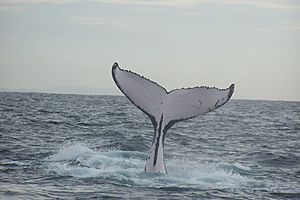
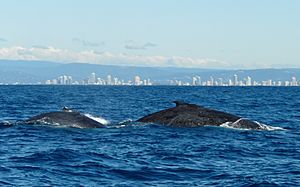
Along Australia's Pacific coast, many places offer whale watching. You can often see whales migrating south from headlands (cliffs sticking out into the sea). Sometimes, whales even swim into Sydney Harbour.
From May to November, which is the peak southern whale watching season, volunteers at Cape Solander in Botany Bay count whales. They do this from sunrise to sunset every year, from May 24th to August 1st, as part of a long-term scientific study.
The Sunshine Coast and Hervey Bay in Queensland are great places to see southern humpback whales. This is from late June to late November each year. Hervey Bay is special because the whales often stay and rest there before continuing their journey. They show many playful behaviors. Every August, Hervey Bay hosts a Whale Festival to celebrate the start of the whale watching season.
Whale numbers have grown a lot in recent years. Other popular spots for tours from May to November include Sydney, Eden, Port Stephens, Narooma, and Byron Bay in New South Wales.
Migaloo the White Whale
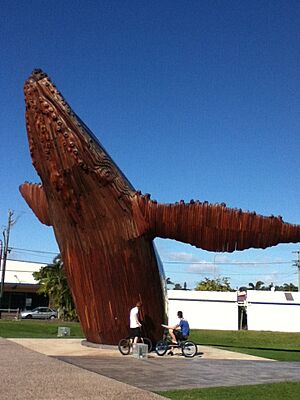
There's a very special whale named Migaloo. He is a true albino, meaning he is all white! Migaloo was first seen in 1991 off Byron Bay. Because he is so unique, both Queensland and New South Wales have laws saying that people must stay at least 500 meters (about 1,640 feet) away from him. This helps keep him safe and undisturbed.


